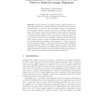Free Online Productivity Tools
i2Speak
i2Symbol
i2OCR
iTex2Img
iWeb2Print
iWeb2Shot
i2Type
iPdf2Split
iPdf2Merge
i2Bopomofo
i2Arabic
i2Style
i2Image
i2PDF
iLatex2Rtf
Sci2ools
ACCV
2007
Springer
2007
Springer
Exploiting Inter-frame Correlation for Fast Video to Reference Image Alignment
Strong temporal correlation between adjacent frames of a video signal has been successfully exploited in standard video compression algorithms. In this work, we show that the temporal correlation in a video signal can also be used for fast video to reference image alignment. To this end, we first divide the input video sequence into groups of pictures (GOPs). Then for each GOP, only one frame is completely correlated with the reference image, while for the remaining frames, upper and lower bounds on the correlation coefficient (ρ) are calculated. These newly proposed bounds are significantly tighter than the existing Cauchy-Schwartz inequality based bounds on ρ. These bounds are used to eliminate majority of the search locations and thus resulting in significant speedup, without effecting the value or location of the global maxima. In our experiments, up to 80% search locations are found to be eliminated and the speedup is up to five times the FFT based implementation and up to ...
| Added | 06 Jun 2010 |
| Updated | 06 Jun 2010 |
| Type | Conference |
| Year | 2007 |
| Where | ACCV |
| Authors | Arif Mahmood, Sohaib Khan |
Comments (0)

